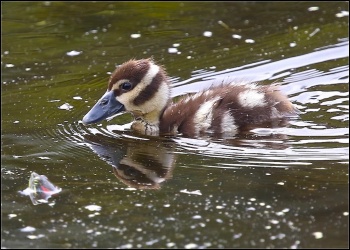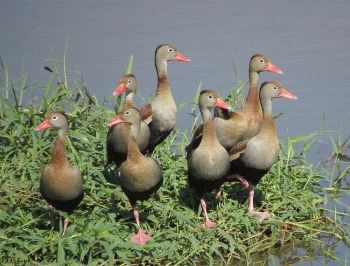Alternative name: Black-bellied Tree-Duck, Red-billed Whistling Duck
- Dendrocygna autumnalis
Identification
L. 20-22" (51-56 cm).
- Tall, long-necked, and long-legged
Adult
- Mainly chestnut and black
- Red bill
- Pink legs
- Large white wing patch visible in flight
Immature
Similar, but much duller
Distribution
USA: Breeds in southern Texas and Arizona, expanding northwards and commonly found in suburban areas around Houston and Dallas. Introduced birds have bred in southern Florida. Casual vagrant to Kansas.
Rest of the Americas: Mexico through Central and South America to Argentina.
Taxonomy
Subspecies
This is a polytypic species. Two subspecies are recognised1:
- D. a. fulgens:
- D. a. autumnalis:
Habitat

Photo © by Stanley Jones
Lafitte’s Cove Nature Preserve, Galveston County, Texas, USA, 2 May 2017
Wooded or tree-lined streams and ponds.
Behaviour
These handsome, conspicuous birds often rest on large tree branches, stakes, or poles in the water, also on the ground, by bodies of water.
Breeding
The 12-16 white eggs are placed in a tree cavity or man-made nest box without a nest lining, occasionally on the ground among reeds.
Diet
Almost entirely herbivorous, they feed in shallow water on tubers and other aquatic vegetation, as well as in grain fields.
Unlike many ducks, this species is largely nocturnal, migrating at night and resting and feeding during the day.
Vocalisation
Squeaky whistles, often in flight.
References
- Clements, J. F., T. S. Schulenberg, M. J. Iliff, D. Roberson, T. A. Fredericks, B. L. Sullivan, and C. L. Wood. 2018. The eBird/Clements checklist of birds of the world: v2018. Downloaded from http://www.birds.cornell.edu/clementschecklist/download/
- Restall et al Birds of Northern South America. Yale University Press. ISBN 9780300124156
- Carboneras, C. & Kirwan, G.M. (2018). Black-bellied Whistling-duck (Dendrocygna autumnalis). In: del Hoyo, J., Elliott, A., Sargatal, J., Christie, D.A. & de Juana, E. (eds.). Handbook of the Birds of the World Alive. Lynx Edicions, Barcelona. (retrieved from https://www.hbw.com/node/52801 on 5 July 2018).
- James, J. D. and J. E. Thompson (2001). Black-bellied Whistling-Duck (Dendrocygna autumnalis), version 2.0. In The Birds of North America (A. F. Poole and F. B. Gill, Editors). Cornell Lab of Ornithology, Ithaca, NY, USA. https://doi.org/10.2173/bna.578
Recommended Citation
- BirdForum Opus contributors. (2024) Black-bellied Whistling Duck. In: BirdForum, the forum for wild birds and birding. Retrieved 28 April 2024 from https://www.birdforum.net/opus/Black-bellied_Whistling_Duck
External Links
GSearch checked for 2020 platform.1






